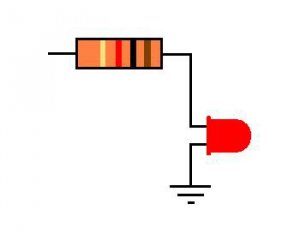If you are not fimular with LED's and want to use them. You may want to print this and put it in your records.
Andy
An LED, or light-emitting diode, requires a supply voltage and current-limiting resistor to work properly. An LED with a color such as infrared, red, green, or yellow usually needs 1.0 to 2.5 volts. More exotic LEDs, such as blue, violet, or white (a combination of several individual LEDs), may require 3 or 4 volts or more. Many multimeters have a diode checking function that will determine a diode's operating voltage.
A typical LED has an anode (+ side) and cathode (- side). It must be connected with the proper polarity. Sometimes the cathode is indicated by a flat spot on the rim of the base of the LED.
Using Ohm's Law, V=IR, you can determine the resistance R to get a desired current through an LED. R = (Supply voltage - LED voltage) / Desired current.
Using an alternate form of Ohm's Law, I=V/R, you can determine the current I that will flow through the LED for a given resistor. I = (Supply voltage - LED voltage) / Given resistor.
From these equations, you can see why the LED needs a resistor. Without one, the only resistance is the wiring between the supply and the resistor. Normal wire has a very low resistance. By Ohm's Law, a very large current will flow and probably destroy the LED. As a rule of thumb, a 1K resistor is a good starting value when connecting an LED.
Andy

An LED, or light-emitting diode, requires a supply voltage and current-limiting resistor to work properly. An LED with a color such as infrared, red, green, or yellow usually needs 1.0 to 2.5 volts. More exotic LEDs, such as blue, violet, or white (a combination of several individual LEDs), may require 3 or 4 volts or more. Many multimeters have a diode checking function that will determine a diode's operating voltage.
A typical LED has an anode (+ side) and cathode (- side). It must be connected with the proper polarity. Sometimes the cathode is indicated by a flat spot on the rim of the base of the LED.
Using Ohm's Law, V=IR, you can determine the resistance R to get a desired current through an LED. R = (Supply voltage - LED voltage) / Desired current.
Using an alternate form of Ohm's Law, I=V/R, you can determine the current I that will flow through the LED for a given resistor. I = (Supply voltage - LED voltage) / Given resistor.
From these equations, you can see why the LED needs a resistor. Without one, the only resistance is the wiring between the supply and the resistor. Normal wire has a very low resistance. By Ohm's Law, a very large current will flow and probably destroy the LED. As a rule of thumb, a 1K resistor is a good starting value when connecting an LED.


